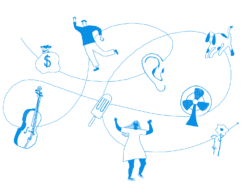Andrew McIntosh: Wilderness, Fear, and Creativity
To begin, I have one acknowledgment to make: despite the fact that this essay is supposedly about my experiences with “wilderness”, I will not actually be using that word in this writing. Most places we call wilderness in the United States were created artificially by forcibly removing people who had lived there for hundreds of years. In the places I will simply call “wild” that I visit most frequently, the indigenous people no longer living on that land were Tongva, Washoe, Mono, Paiute, Shoshone, and Miwok.
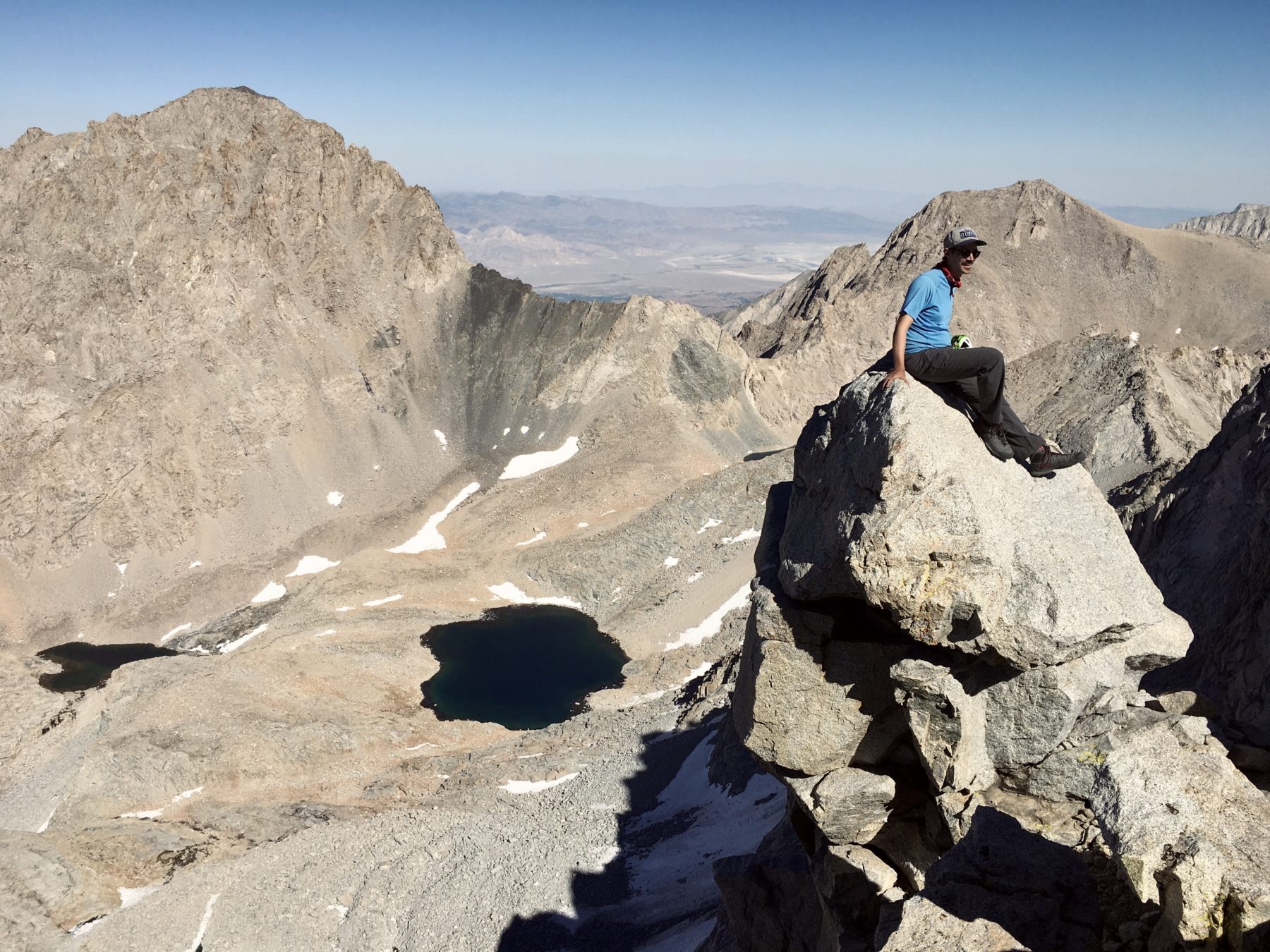
Sequoia National Park, CA, August 2020
Photo credit: Ian Walker
1. Attention
“When you truly understand one thing, a hawk, a juniper tree, a rock, you will begin to understand everything.”
― Ellen Meloy, Eating Stone: Imagination and the Loss of the Wild
“Attention is the beginning of devotion.”
― Mary Oliver, Upstream
When I am able, I hike and I climb. I have a deep love for California’s wild places, its mountains in particular, and exploring them has been a prominent feature of my existence as an adult. When I return from these visits, I often have a difficult time answering questions about the trip, since my understanding of it is experiential and not verbal. I am writing now to find words that share why I do this and what it is like, and also to understand better for myself why I continue to prioritize these physical and mental trials through immersion in places of wonder.
As a child I internalized a love of and familiarity with desert, openness, and solitude, growing up in rural Northern Nevada where the high desert landscape of basin and range meets the eastern escarpment of the Sierra mountains. My father was a geologist and he often took his kids along on work trips, where we learned an intimate connection to the land, with its rich smells, impossible contrasts, harsh beauty, hidden vestiges of past inhabitants, and the ever-changing light depending on time of day and season. When we were teenagers he connected my brother and I with freelance soil sampling and claim-staking jobs for mining companies, which would take place during breaks from school in remote parts of the Nevada desert. Those geology-adjacent experiences were the starting point for my love of mountains and wild places as an adult.
A common question I get upon return from the wild is “How was your vacation?”, which always feels jarring, since I view these trips as more of an ascetic personal practice than a vacation, and they feel intimately connected to my vocations of composing, performing, and teaching.
When I go into the wild I am not generally thinking about music. If I do think about music then it’s because I get a terrible and tiny repetitive pattern stuck as an ear worm in lock step with my feet. However, the focus of attention required on a hike or climb has the side effect of decluttering my brain, so that when I return to creative work I can think more clearly. There have been quite a few times when I’ve made the choice to go on a climb despite being up against a deadline. I generally don’t think at all about the project while climbing, but when I come back I am able to work more fluidly, efficiently, and creatively.
Sometimes when I’m very tired (particularly on a descent, when the motivation of reaching the top has come and gone), I focus simply on finding the joy in every step. My feet might hurt and my knees might be wobbly, but giving attention to the simple sensation of being a moving breathing animal in a place of wonder is enough to keep going simply for the joy of it.
Of course, joy is not always the emotion I experience in the wild. Whatever emotions I am processing at the time are crystallized and felt more intensely when I am in a quiet open space. The amount of energy I invested in hiking and climbing increased dramatically after my father’s death, as well as during other significant life changes. Allowing grief or sadness to have the place they need is difficult for me in my hectic urban musician and teacher life (although not so hectic at the moment, due to the pandemic). Spending time in the wild can distill emotions and feelings that aren’t getting processed in daily life and allow them the space they need.
One aspect of being in the wild is that beauty is always there for the finding, if you direct your attention to it. Our planet is a strange and glorious place, and when in a focused mental state, through the stimulation of physical activity, the brain is opened up to receiving that strangeness and glory. There is a kind of high that comes from the physical effort, facilitating focused attention on both tiny details and vast expanses.
When I write music I try to also devote this intensity of attention to sound. When I am the happiest with music I’ve composed, I rarely feel like I created something – I feel like I found it. The effort is not in the act of creation, it’s in the act of searching. This mental wandering through sounds that don’t yet exist is the most basic aspect of composition for me, and one of the ways I learn how to access that part of my mind is by engaging in physical effort in places of wild beauty (physical effort being anything from simply sitting still to climbing vertical terrain).
It is also why I always write first with a pen, ruler, and blank paper. Complicated tools like a piano or a violin, or a computer, or even paper with staff lines already drawn, can distract substantially from the concentration that I need when searching for sounds that don’t yet exist.
Why do I go into the wild?
I go in pursuit of beauty
I go in pursuit of calm
I go to feel both very small and very proud at the same time
I go to be reminded of how insignificant I am
I go to observe systems at work beyond human control
I go to feel alive
I go to feel my body
I go to feel what it is like to work through fear
I go to feel accomplishment
I go to feel
I go to think
I go to focus my attention on tiny things
I go to focus my attention on expansive things
I go to focus my attention on beautiful things
I go to focus my attention on one thing at a time
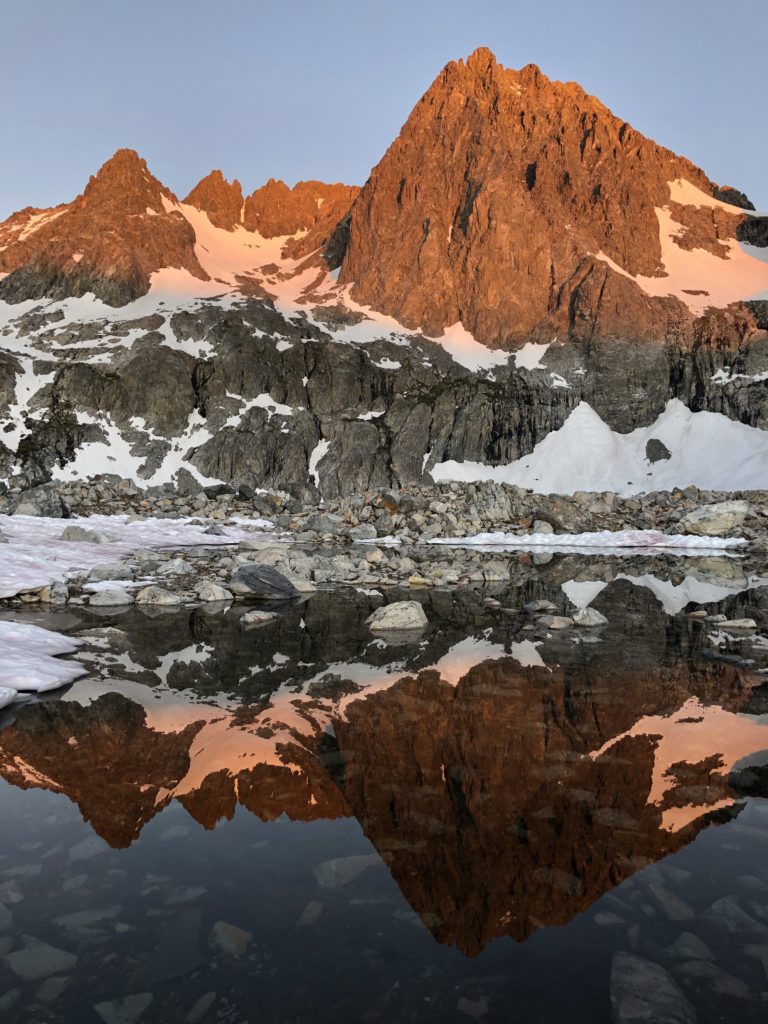
2. Fear
“I would like to do whatever it is that presses the essence from the hour.”
― Ellen Meloy, The Anthropology of Turquoise: Reflections on Desert, Sea, Stone, and Sky
“When all of a person’s relevant skills are needed to cope with the challenges of a situation, that person’s attention is completely absorbed by the activity. There is no excess psychic energy left over to process any information but what the activity offers. All the attention is concentrated on the relevant stimuli. As a result, one of the most universal and distinctive features of optimal experience takes place: people become so involved in what they are doing that the activity becomes spontaneous, almost automatic; they stop being aware of themselves as separate from the actions they are performing.”
― Mihalyi Csikszentmihalyi, Flow: The Psychology of Optimal Experience
As a human I am often full of fear: fear of performing, of speaking publicly, of social situations, of social media, of meeting new people, of making decisions, of sharing things I care about. Climbing teaches me how to live with and manage those fears, acknowledging and respecting them without letting them hinder a life lived fully.
There are two things I learn over and over again every time I climb
- When I think about the whole mountain or the whole route I am sometimes paralyzed with fear and intimidation, but when I focus my attention on each step or movement individually then it is usually completely manageable.
- There is almost always a moment, often about a quarter of the way in, when I become overwhelmed with doubt and consider turning back (and sometimes I do – if I feel I’m in over my head). I have never regretted it when I decided to keep going.
I will never forget the first time my brother took me rock climbing outdoors. Halfway up the climb I reached a point where I could not figure out how to position my body to be able to continue moving upwards. I panicked. My heart raced, my breath was shallow, and my rational mind shut down. I froze. I gripped the rock as hard as I could until my arms shook and I had no strength left. I looked down and saw only air beneath my feet. I was afraid to let go and rest, even though I was supported by the rope, and I was completely paralyzed and stuck. For a few minutes I was 100% absolutely and completely miserable. Eventually my brother talked me into relaxing and resting on the rope. I breathed, I regained my rational mind, and I pleaded with my brother, belaying on the other end of the rope, to lower me back to the ground. He did not. He encouraged me to try again to find a way through the crux of the climb, and talked me through where to place my hands and feet so that I discovered it was actually not so difficult to move upwards once my body was in balance as I was ascending. I am so glad he encouraged me to keep going in that moment, since I learned one of the most powerful lessons I have learned from climbing: that the challenges of climbing are primarily mental, not physical, and that overcoming fear is possible and can lead to euphoria.
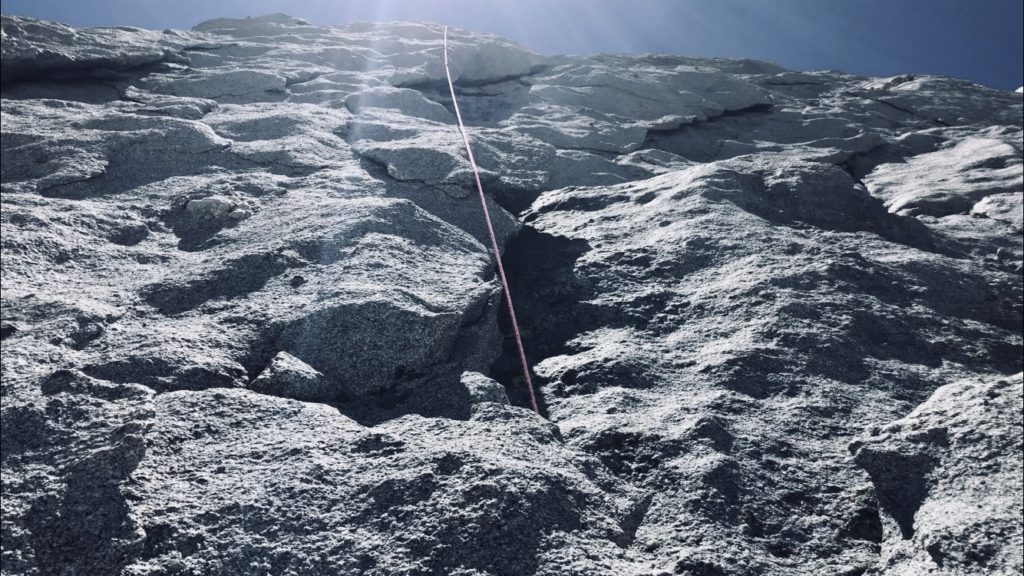
Often when I’m climbing with my brother, a climber of extraordinary ability and experience who loves to raise the level of difficulty every time we climb together, he says three words that annoy me profoundly when I am stuck or afraid: “Trust your feet”. However much I might be irritated by that advice in the moment, those words are full of truth. I tend to make climbs much harder than they need to be by clenching and searching for handholds to cling to, when the climb would be fairly easy if I could relax and stand on my feet. Not only does trusting your feet and relinquishing the desire for upper body control make the climb easier, it also makes the movement more graceful and enjoyable.
As someone who performs on stage for a living, I often struggle with intense performance nerves. Learning how to overcome fear while rock climbing has directly helped my ability to perform, providing mental training for working through the severe anxiety I sometimes experience on stage. In both performing and composing, trust is the crucial element that allows me to move forward when I’m paralyzed by fear. There isn’t a one-to-one correlation with “trusting your feet”, but trusting the years of training and practice, trusting the hours of concert preparation, trusting instinct, trusting imagination, trusting the familiarity with the instruments and the sound, trusting collaborators, and even trusting the listener to be accepting of what is shared are all paths forward when fear threatens paralysis.
I have been a performing musician since age five, but have only started climbing in the last few years. Being a beginner at something that shares so many mental states with my primary artistic practice has been humbling and illuminating. Through climbing, I have re-learned how to learn: how to be stuck, frustrated, and afraid, feeling hopelessly incapable and naive, and then apply an uncomfortably fresh new skill in the moment and experience it working.
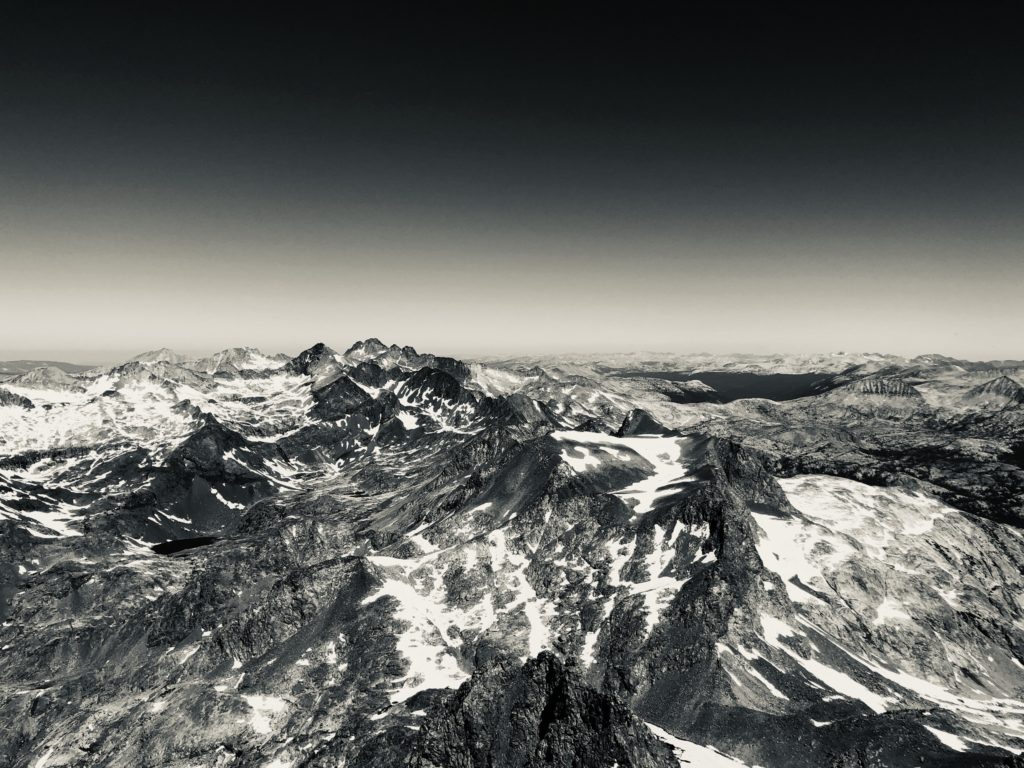
3. Beauty
“No one yet has made a list of places where the extraordinary may happen and where it may not. Still, there are indications. Among crowds, in drawing rooms, among easements and comforts and pleasures, it is seldom seen. It likes the out-of-doors. It likes the concentrating mind. It likes solitude. It is more likely to stick to the risk-taker than the ticket-taker. It isn’t that it would disparage comforts, or the set routines of the world, but that its concern is directed to another place. Its concern is the edge, and the making of a form out of the formlessness that is beyond the edge.”
― Mary Oliver, Of Power and Time
“Of all the things I wondered about on this land, I wondered the hardest about the seduction of certain geographies that feel like home — not by story or blood but merely by their forms and colors. How our perceptions are our only internal map of the world, how there are places that claim you and places that warn you away. How you can fall in love with the light.”
― Ellen Meloy, The Anthropology of Turquoise: Reflections on Desert, Sea, Stone, and Sky
The beauty of solitude
The beauty of risk
The beauty of quiet
The beauty of wind
The beauty of being in a place you can only get to by walking there
The beauty of being in wild places few humans get to see
The beauty of watching a bird fly below you
The beauty of watching the sun rise from halfway up a mountain
The beauty of looking across to the sky as an equal
The beauty of looking down to the ground below as something you have left behind
The beauty of being perched on a summit with spacious distance in every direction
The beauty of learning you can do more than you thought you could
The beauty of learning to commit to something
The beauty of learning to trust in yourself
The beauty of learning to trust in your companions
The beauty of learning that overcoming fear is achievable
The beauty of ecstasy
The beauty of expanse
The beauty of following a path
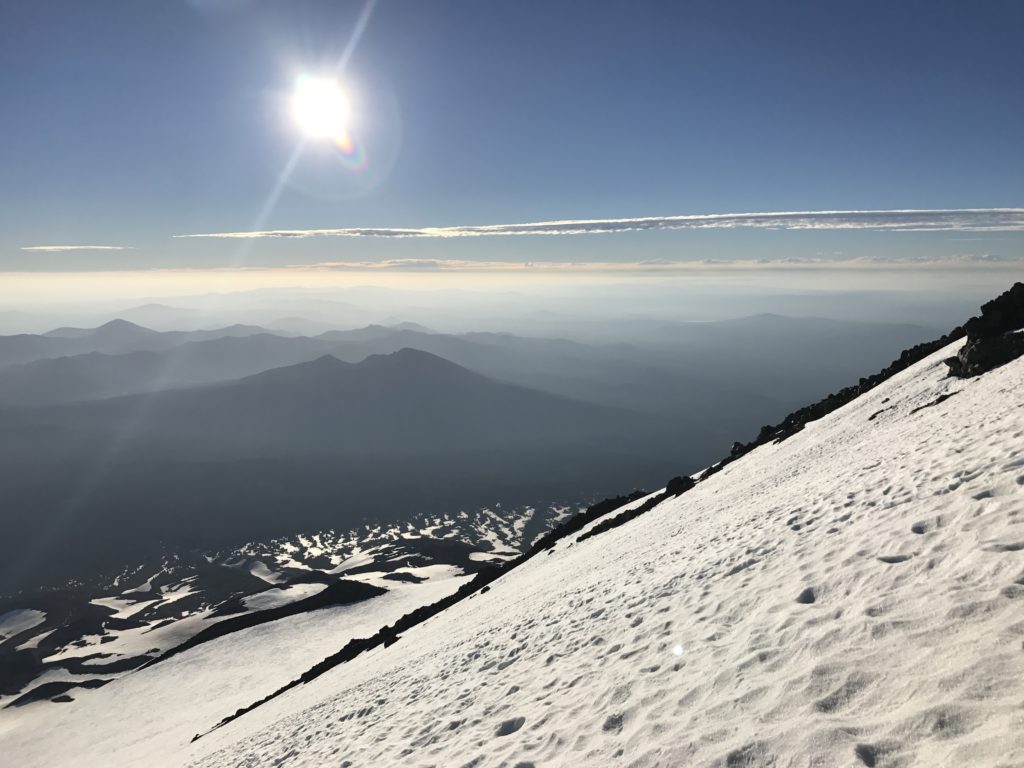
4. Effort
“…it is when we act freely, for the sake of the action itself rather than for ulterior motives, that we learn to become more than what we were. When we choose a goal and invest ourselves in it to the limits of our concentration, whatever we do will be enjoyable. And once we have tasted this joy, we will redouble our efforts to taste it again.”
― Mihalyi Csikszentmihalyi, Flow: The Psychology of Optimal Experience
“RULE SEVEN: The only rule is work. If you work it will lead to something. It’s the people who do all of the work all of the time who eventually catch on to things.”
― John Cage, Ten Rules for Students and Teachers
Several years ago I set a goal for myself of summiting all fifteen of California’s peaks over 14,000 feet in elevation before I turn 40. As of last week I’ve now climbed six of them, and I have five years left for the other nine. There’s nothing particularly significant about any of those numbers, but having that goal in the background has provided a structure to my outdoor efforts and incentive to grow my ability as a climber.
The word “climb” can mean radically different things to people. Many people talk about climbing Mt. Whitney, when what they mean is walking up the trail that leads all the way to its summit. People who identify as climbers often use the word strictly to refer to vertical terrain, anything short of that being a hike, scramble, or slog. If I’m referring to something as a climb it generally means that I’m using my hands for upward movement as well as my feet, ranging from using an ice ax on a 30º snow slope to vertical rock. Climbing also has many different categories: bouldering, top-roping, sport, trad, single-pitch, multi-pitch, aid, free, solo, snow, ice, and alpine climbing. Only a tiny percentage of these different types of climbing lead to mountain summits – and that is where my particular interest in climbing lies.
My older brother and I started going on summer backpacking trips in the Sierras about eight years ago, and my love of mountains combined with his love of climbing so that our itineraries gradually became steeper until they stopped being hikes and started becoming climbs. To paint a picture of what is involved in a technical alpine climb in the Sierras, I’ll walk through all the steps that were involved in climbing 14,153-foot Mt. Sill (Nen-i-mish in the Paiute language) last September with my brother, via the classic Swiss Arete – a 600-foot-tall near-vertical ribbon of clean granite that hangs directly from the summit of California’s sixth-highest peak, suspended above a narrow ridge dividing two glaciers hundreds of feet below.
The conditioning included several months of hikes in our local San Gabriel Mountains (to get my legs and lungs working again after the seasonal teaching and concertizing that prevent me from doing any serious outdoor activity for most of the year), a solo backpacking trip in Northern California’s Trinity Alps, a solo snow climb of Mt. Adams (Washington State’s second-highest peak), and a 10-pitch 5.8 rock climb with my brother in the North Cascades that was a bit harder in difficulty than Swiss Arete, but in a less committing environment (at only 8000 feet elevation instead of 14,000 feet, and only 2 miles from the car on a trail instead of 12 miles involving a glacier crossing). After all of that I finally felt ready to attempt the Swiss Arete, and my brother was willing to do it with me.
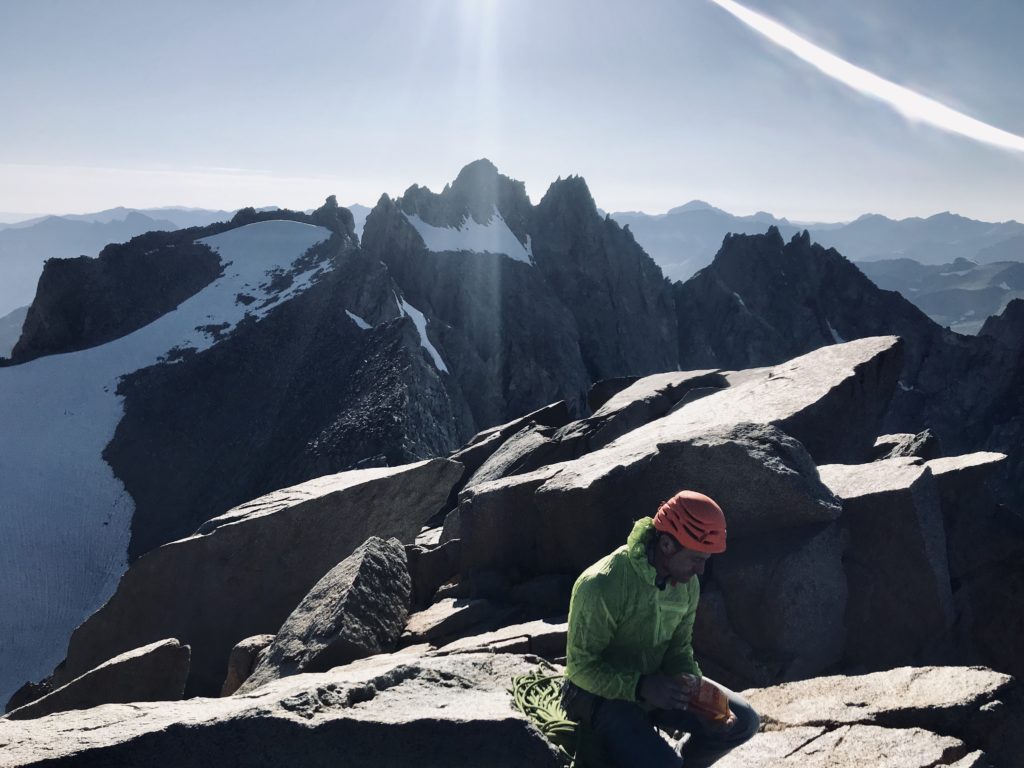
Kings Canyon National Park, CA September 2019
We met at my apartment in Los Angeles late at night, did a gear check, and packed our 50+ pound packs full with three days of food, camping equipment, water, a water filter, warm clothes, a 70-meter rope, ice axes, crampons, gaiters, hiking boots, climbing shoes, chalk, helmets, and all of the considerable gear for trad climbing (harnesses, nuts, cams, slings, carabiners, draws, belay devices, and cordelette). We set alarms for 4:00 am and drove four hours to the trailhead, so that we could get out of the Owen’s Valley heat earlier in the day as we hiked eight miles up into the Sierras to our base camp at 11,000 feet elevation. The next morning we hiked another thousand feet up in elevation to the top of a ridge, then through a large talus field, carefully crossed the Palisade Glacier – the largest glacier that far south in North America (not as dangerous as glaciers further north, but still significant, with steep sections and small crevasses), scrambled up sketchy loose rock to a ridge above the glacier, crossed another steep snow field, and scrambled up 3rd and 4th class rock for several hundred more vertical feet (4th class climbing is often likened to climbing a ladder, but hundreds of feet in the air – not quite technical rock climbing, but still serious). At this point, many hours after leaving base camp, we had arrived at the beginning of the actual climbing route. Above us loomed five pitches (rope lengths) of beautiful, clean, solid Sierra granite. My brother led all of the pitches, meaning that I belayed him from below while he climbed first and placed protective gear in cracks in the rock as he went, then he would build an anchor at a ledge and belay me from above while I climbed and removed the gear from the rock. The psychological crux of the climb involved blindly stepping around an exposed corner, trusting a smooth steeply-sloping slab with one foot while reaching around for a handhold out of sight, swinging my body around the corner above 500 feet of air below and trusting there would be another handhold available – all the while knowing that a slip would result in a pendulum swing on the rope that would pull me off route into much harder climbing. It was intimidating, but fun, and went off without a hitch. After several hours on the climb, we found that the last couple moves led directly onto the narrow and gorgeous summit. Words cannot even begin to describe the beauty and vastness visible in every direction from that airy perch. We didn’t stay there long, though, because it was late in the day and we still had to descend. In this case the descent meant down-climbing an easier climbing route (4th class). We carefully made our way down to the upper snow field, but by this time it had gotten colder and windier and the snow had become icy. We retraced our steps slowly back down to the Palisade Glacier and crossed the glacier and talus field after dark. By the time we made it back to our base camp, after a bit of a detour due to getting off-route in the dark, we had been in motion for almost 15 hours, with only a few small breaks. The next morning we packed everything up, hiked out to the car, and drove back to Los Angeles full of wonder and satisfaction.
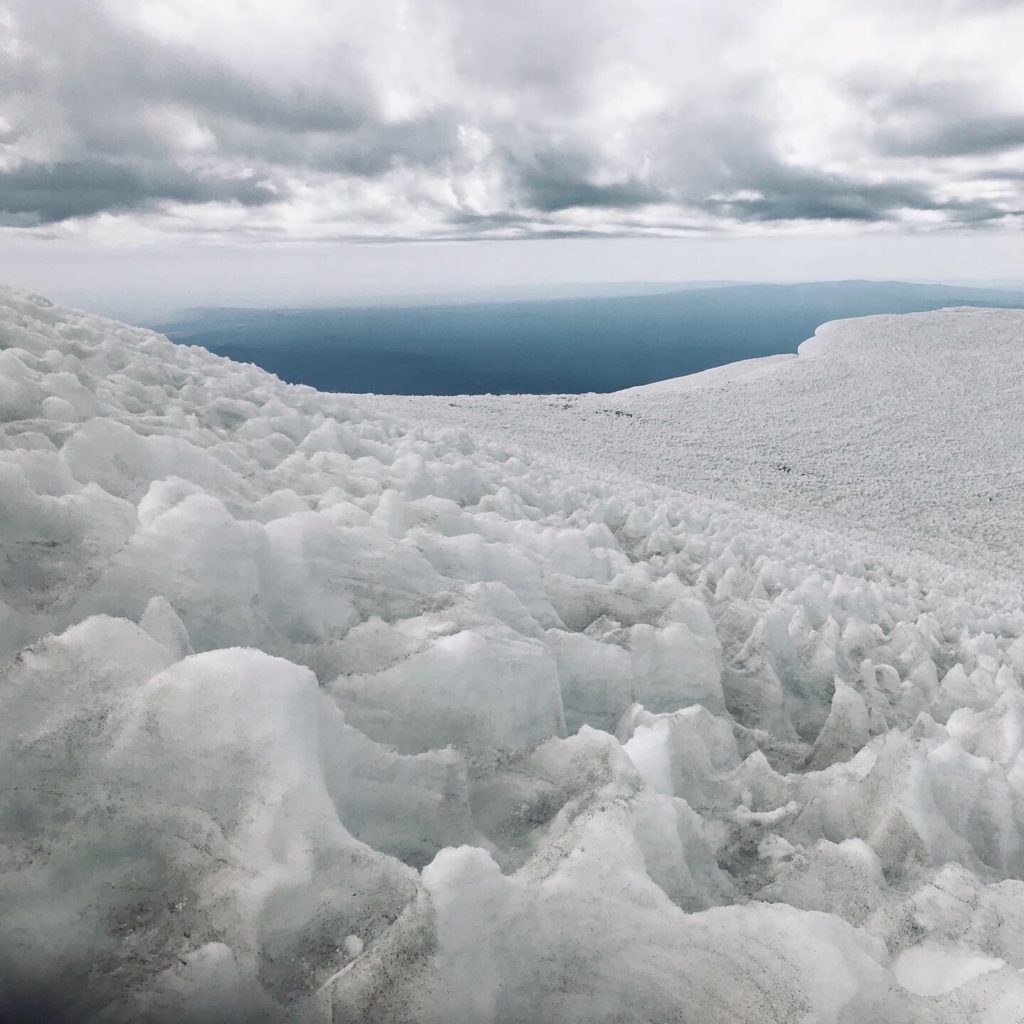
Near the summit of Mt. Adams (12,276 ft)
Gifford-Pinchot National Forest, WA
July 2019
Alpine climbing involves not only physical effort and preparation, but also sustained concentration. It is excellent mental conditioning for learning how to direct attention for long durations and on long-term goals. Writing music also requires sustained concentration, and somehow the two activities don’t actually feel all that different to me in terms of how I use my brain.
Composing music, as I see it, comes down to four basic skills:
- listening, with intense detail and complete attention, to what is there (on a page or in the air)
- listening, with intense detail and complete attention, to what is not yet there (in your head)
- experimentation (letting curiosity guide the sound)
- figuring out how best to communicate and share those sounds with others
When composing, the first image I have is often of the whole structure of a new work, and then I slowly fill in one detail at a time until it is complete. For me it is significantly more tiring than playing violin, because of the intensity of mental effort required. I often fall asleep shortly after spending time writing. Once I have a complete draft I sometimes rewrite the whole piece or portions of it, and usually edit extensively. Because my imagination tends to think big picture first, it is easy for me to dream up giant projects, but then it takes years to finish them. I have at least four such unfinished projects I’m working on at the moment. The amount of work it takes to follow through and complete a composition is often staggering and intimidating, but the path forward is more fluid if I can find joy in the process by simply directing attention fully to each step at a time, focusing completely on what is immediately in front of me, and maintaining concentration.
Through climbing, I am reminded of how to find the mental discipline needed for creative work. It declutters my mind and I re-learn how to focus attention for sustained periods. It reminds me of the value of persevering through intimidation and uncertainty, rather than turning back. Being in the wild can also allow current emotions the space they need. And, last but not least, climbing brings me to places of untamed and immense beauty. When writing, I aspire to distill and reflect those images, impressions, and experiences in sound.
“Creative work needs solitude. It needs concentration, without interruptions. It needs the whole sky to fly in, and no eye watching until it comes to that certainty which it aspires to, but does not necessarily have at once.”
― Mary Oliver, Of Power and Time
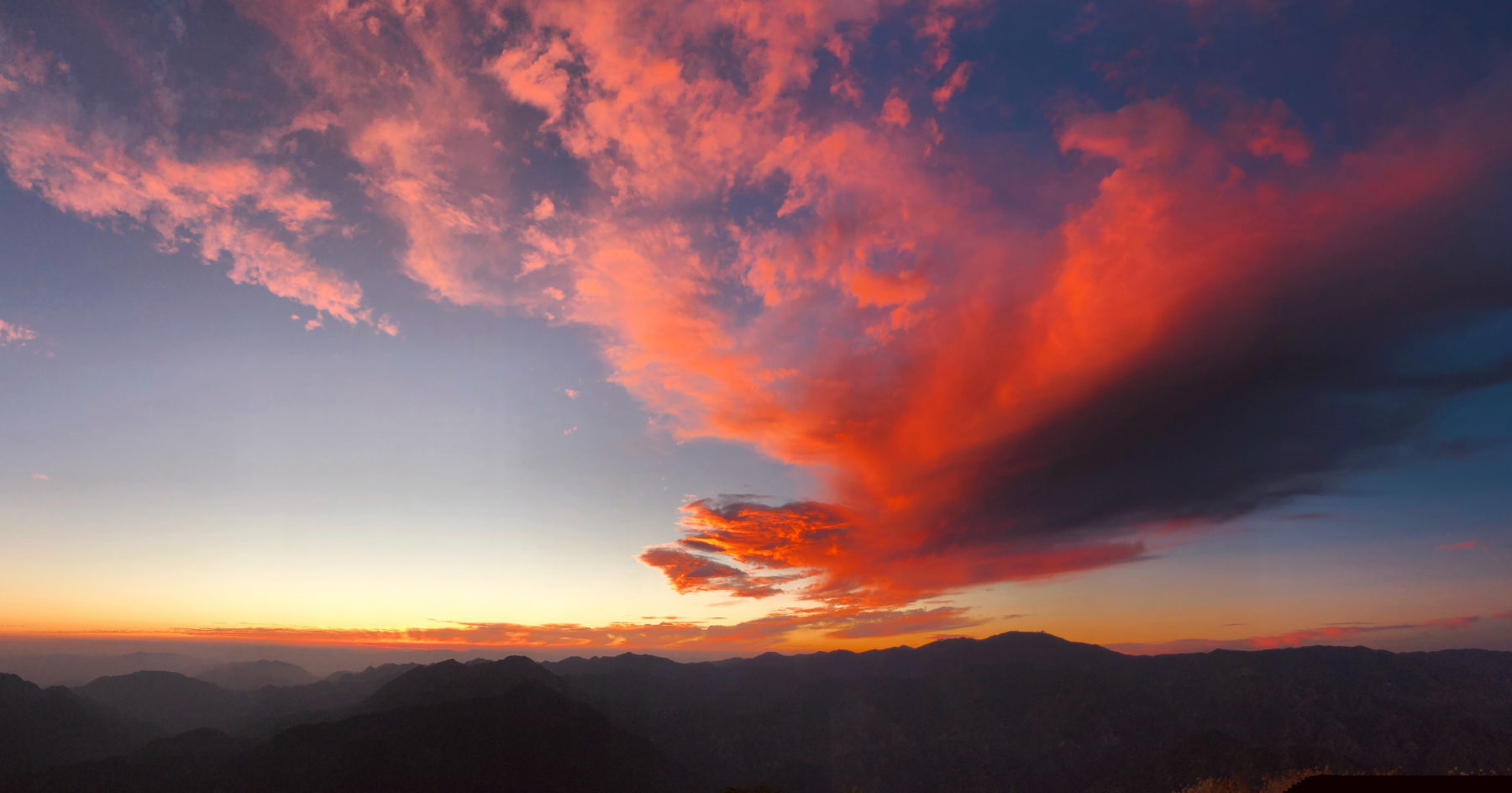
text and photos by Andrew McIntosh
for more on Andrew
See Andrew summiting Mt Tyndall and talking about all sorts of wilderness adjacent things, like his favorite fruit, as part of our Fan Club, on Patreon
